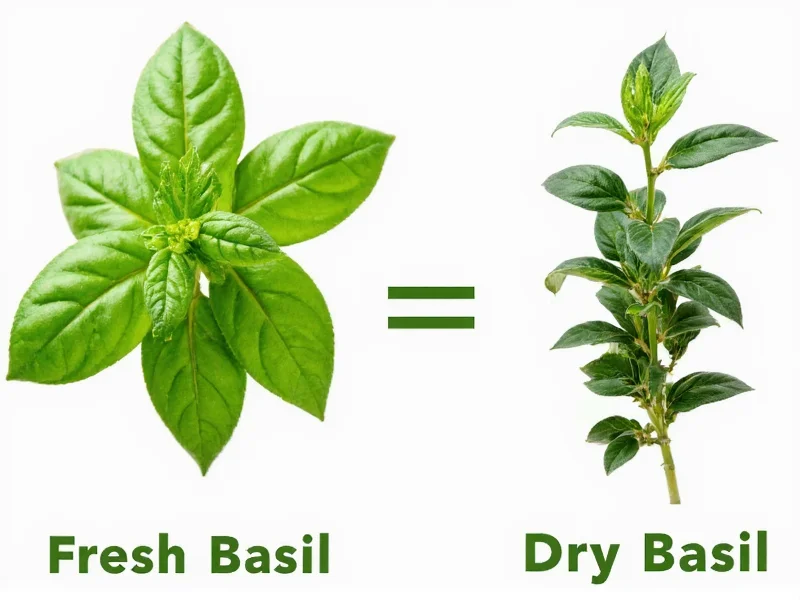Understanding herb conversions is essential for achieving perfect flavor balance in your cooking. When substituting fresh basil for dried (or vice versa), this 3:1 ratio serves as your foundational guideline. The difference stems from the dehydration process—fresh basil contains approximately 90% water, while dried basil has most moisture removed, resulting in a more concentrated flavor profile.
Getting this ratio right prevents under-seasoned dishes or overpowering herb flavors that can ruin your culinary creations. Whether you're making pesto, tomato sauces, or caprese salad, proper herb measurement ensures authentic taste and professional results.
Why the 3:1 Fresh Basil to Dried Basil Ratio Works
The science behind this conversion ratio lies in water content and flavor concentration. Fresh basil leaves contain significant moisture that dilutes their essential oils. When basil dries, this water evaporates, leaving behind a more potent herb with intensified flavor compounds.
Chef Marco Ricci, a culinary instructor with 15 years of Mediterranean cuisine experience, explains: "Dried herbs generally have three times the flavor concentration of their fresh counterparts because you're removing the water weight. This isn't just about measurement—it's about understanding how flavor compounds behave differently in various states."
Fresh Basil to Dried Basil Conversion Chart
| Fresh Basil | Dried Basil | Best For |
|---|---|---|
| 1 teaspoon | ⅓ teaspoon | Finishing dishes, garnishes|
| 1 tablespoon | 1 teaspoon | Sauces, dressings|
| ¼ cup | 1½ tablespoons | Stews, braises|
| ½ cup | 3 tablespoons | Long-cooking dishes|
| 1 cup | ½ cup | Large batch cooking
When to Adjust the Standard Ratio
While the 3:1 ratio works for most applications, several factors may require slight adjustments:
- Recipe cooking time: For dishes simmering longer than 30 minutes, reduce dried basil by 25% as flavors intensify over time
- Storage duration: Dried basil loses potency after 6 months—use 20% more if your dried herbs are older
- Personal preference: Some palates detect basil's anise notes more strongly in dried form
- Recipe acidity: In tomato-based dishes, increase dried basil by 15% to counter acidity
Fresh vs. Dried Basil: Flavor Profiles and Best Uses
Understanding when to use each form elevates your cooking beyond simple substitution:
Fresh Basil Applications
Use fresh basil when you want bright, grassy notes with subtle peppery undertones. It shines in:
- Pesto (where its oils emulsify with olive oil)
- Cold dishes like caprese salad
- Finishing pizzas or bruschetta
- Short-cooking sauces added at the end
Dried Basil Applications
Dried basil offers a more concentrated, slightly sweeter profile ideal for:
- Long-simmering tomato sauces
- Marinades where penetration matters
- Baked goods like focaccia
- Dry rubs for meats
Common Substitution Mistakes to Avoid
Even experienced cooks make these errors when converting fresh basil to dried:
- Adding dried herbs too late: Dried basil needs 15-20 minutes in liquid to rehydrate and release flavors
- Using the same addition timing: Add dried basil early in cooking; fresh basil in the last 5 minutes
- Ignoring leaf size: Large-leaf Genovese basil has milder flavor than small-leaf varieties
- Not toasting dried basil: Lightly toasting dried basil in a dry pan boosts flavor by 30%
Storage Tips for Maximum Flavor Preservation
Proper storage affects your conversion accuracy:
- Fresh basil: Store stems in water like flowers (change water every 2 days); lasts 7-10 days refrigerated
- Dried basil: Keep in airtight container away from light; peak potency lasts 6 months
- Freezing fresh basil: Blend with olive oil and freeze in ice cube trays for perfect portioning
Professional Chef Tips for Perfect Basil Substitution
Top culinary professionals use these advanced techniques:
- Rehydration method: For dried basil in cold applications, soak 1:1 with warm water for 10 minutes before use
- Flavor balancing: When substituting dried for fresh, add ¼ teaspoon lemon zest per tablespoon to mimic fresh herb brightness
- Layering technique: Use 75% dried basil early in cooking plus 25% fresh at the end for complex flavor profiles











 浙公网安备
33010002000092号
浙公网安备
33010002000092号 浙B2-20120091-4
浙B2-20120091-4